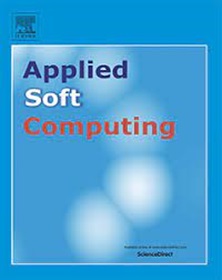Joint hierarchical multi-granularity adaptive embedding discriminative learning for unsupervised domain adaptation
IF 7.2
1区 计算机科学
Q1 COMPUTER SCIENCE, ARTIFICIAL INTELLIGENCE
引用次数: 0
Abstract
Unsupervised domain adaptation (UDA) is an effective technique that aims to transfer knowledge from well-labeled source data to target data that lacks labels and has a different distribution. Most existing methods only considered domain center-wise alignment to reduce global differences across domains, resulting in a coarse alignment. In recent years, researchers further considered aligning class centers to ensure the consistency of local distributions. However, these methods utilized a solely mean vector to represent the entire class distribution, which is still coarse and cannot fully capture the distribution characteristics of intra-class data. Inspired by the “knowledge pyramid” theory, a novel UDA method termed adaptive hierarchical multi-granularity embedded learning (HMGEL) is proposed to solve this problem, which aims to minimize the distribution gap of samples across domains from the perspective of hierarchical multi-granularity. This method can reflect the distribution of samples from coarse to fine, which is helpful for better UDA. Firstly, granular envelopes are created to explore intra-class structures and complex distributional properties at a more fine-grained level. Based on the granular envelopes, domain centers and class centers are combined for cross-domain distribution alignment, allowing for the capture of sample information at hierarchical multi-granularity from coarse to fine. Then, a robust sample-to-granular envelope cross-domain local structure learning strategy is designed to improve the discrimination capability of target domain features under hierarchical multi-granularity. Extensive experiments on five benchmark datasets show that the proposed HMGEL method is effective at a significant level.
联合分层多粒度自适应嵌入判别学习的无监督域自适应
无监督领域适配(UDA)是一种有效的技术,旨在将知识从具有良好标签的源数据转移到缺乏标签且分布不同的目标数据。现有的大多数方法只考虑域中心对齐,以减少跨域的全局差异,结果是粗略对齐。近年来,研究人员进一步考虑了类中心对齐,以确保局部分布的一致性。然而,这些方法仅利用平均向量来表示整个类的分布,仍然比较粗糙,无法完全捕捉类内数据的分布特征。受 "知识金字塔 "理论的启发,一种名为自适应分层多粒度嵌入式学习(HMGEL)的新型 UDA 方法被提出来解决这一问题,该方法旨在从分层多粒度的角度最小化样本在不同领域间的分布差距。这种方法能反映样本从粗到细的分布,有助于更好地进行 UDA。首先,创建粒度包络,以便在更细的层次上探索类内结构和复杂的分布特性。在粒度包络的基础上,结合域中心和类中心进行跨域分布对齐,从而捕捉到从粗到细的多粒度分层样本信息。然后,设计一种稳健的样本到粒度包络跨域局部结构学习策略,以提高目标域特征在分层多粒度下的辨别能力。在五个基准数据集上的广泛实验表明,所提出的 HMGEL 方法在很大程度上是有效的。
本文章由计算机程序翻译,如有差异,请以英文原文为准。
求助全文
约1分钟内获得全文
求助全文
来源期刊

Applied Soft Computing
工程技术-计算机:跨学科应用
CiteScore
15.80
自引率
6.90%
发文量
874
审稿时长
10.9 months
期刊介绍:
Applied Soft Computing is an international journal promoting an integrated view of soft computing to solve real life problems.The focus is to publish the highest quality research in application and convergence of the areas of Fuzzy Logic, Neural Networks, Evolutionary Computing, Rough Sets and other similar techniques to address real world complexities.
Applied Soft Computing is a rolling publication: articles are published as soon as the editor-in-chief has accepted them. Therefore, the web site will continuously be updated with new articles and the publication time will be short.
 求助内容:
求助内容: 应助结果提醒方式:
应助结果提醒方式:


